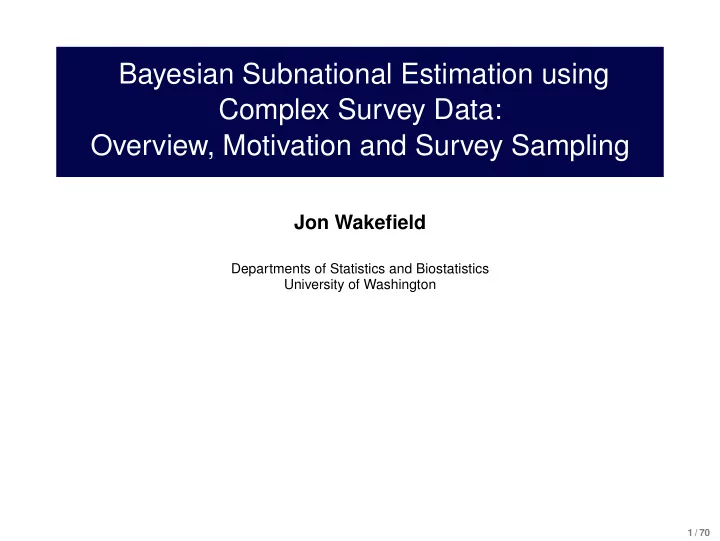

Bayesian Subnational Estimation using Complex Survey Data: Overview, Motivation and Survey Sampling Jon Wakefield Departments of Statistics and Biostatistics University of Washington 1 / 70
Outline Overview Motivating Data Smoothing and Bayes Survey Sampling Design-Based Inference Complex Sampling Schemes Discussion 2 / 70
Overview 3 / 70
Terminology • Charactering and understanding subnational variation in health and demographic outcomes is an important public health endeavor. • Many outcomes are binary, or public health targets are binary. • For example, in the Sustainable Development Goals (SDGs), Goal 3.2 states, “By 2030, end preventable deaths of newborns and children under 5 years of age, with all countries aiming to reduce neonatal mortality to at least as low as 12 per 1,000 live births and under-5 mortality to at least as low as 25 per 1,000 live births”. • With respect to binary objectives, prevalence is defined as the proportion of a population who have a specific characteristic in a given time period. • Examination of these proportions across space, is known as prevalence mapping – we may map continuously in space, or across discrete administrative areas. 4 / 70
Terminology • “The problem of small area estimation (SAE) is how to produce reliable estimates of characteristics of interest such as means, counts, quantiles, etc., for areas or domains for which only small samples or no samples are available, and how to assess their precision.” (Pfeffermann, 2013). • SAE methods provide one approach to performing prevalence mapping, for administrative areas. • “The term geostatistics is a short-hand for the collection of statistical methods relevant to the analysis of geolocated data, in which the aim is to study geographical variation throughout a region of interest, but the available data are limited to observations from a finite number of sampled locations.” (Diggle and Giorgi, 2019) • Model-based geostatistics (MBG) provide another approach to performing prevalence mapping, over continuous space, though these continuous surfaces can be averaged for area-level inference. 5 / 70
Overview of Lecture Series • Data: We consider the situation in which the available data arise from surveys with a complex design. • A Problem: If small sample sizes in some areas/time periods, there is high instability. In the limit, there may be no data... • Survey Sampling Methodology: Required for design and analysis. • Shrinkage and Spatial Smoothing: To reduce instability, use the totality of data to smooth both locally and globally over space. • Bayesian Modeling: Is convenient for encoding notions of smoothing, and for carrying out inference. • Implementation: In R programming environment, using the SUMMER package. • Visualization: Maps of uncertainty, accompanied with uncertainty, produced using the GIS capabilities of R . 6 / 70
Overview of Lecture Series Lectures: • Complex Survey Data. • Bayesian Smoothing Models. • Prevalence Mapping. • Implementation, with examples, via the SUMMER package – lectures by Zehang Richard Li. Website: http://faculty.washington.edu/jonno/space-station.html The examples presented will mostly concern subnational estimation of under-5 mortality risk (U5MR). 7 / 70
Demographic Health Surveys • Motivation: In many developing world countries, vital registration is not carried out, so that births and deaths go unreported. • Objective: To provide reliable estimates of demographic/health indicators at the (say) Admin1 or Admin2 level 1 , at which policy interventions are often carried out. • We will illustrate using data from Demographic Health Surveys (DHS). • DHS Program: Typically stratified cluster sampling to collect information on population, health, HIV and nutrition; more than 300 surveys carried out in over 90 countries, beginning in 1984. • The Problem: Data are sparse, at the Admin2 level in particular. • SAE: Leverage space-time similarity to construct a Bayesian smoothing model. 1 Admin0 = country level boundaries, Admin1 = first level administrative boundaries (states in US), Admin 2 = second level administrative boundaries (counties in US) 8 / 70
Recommend
More recommend